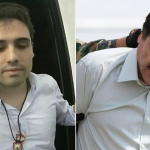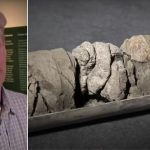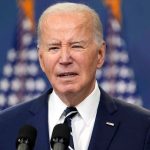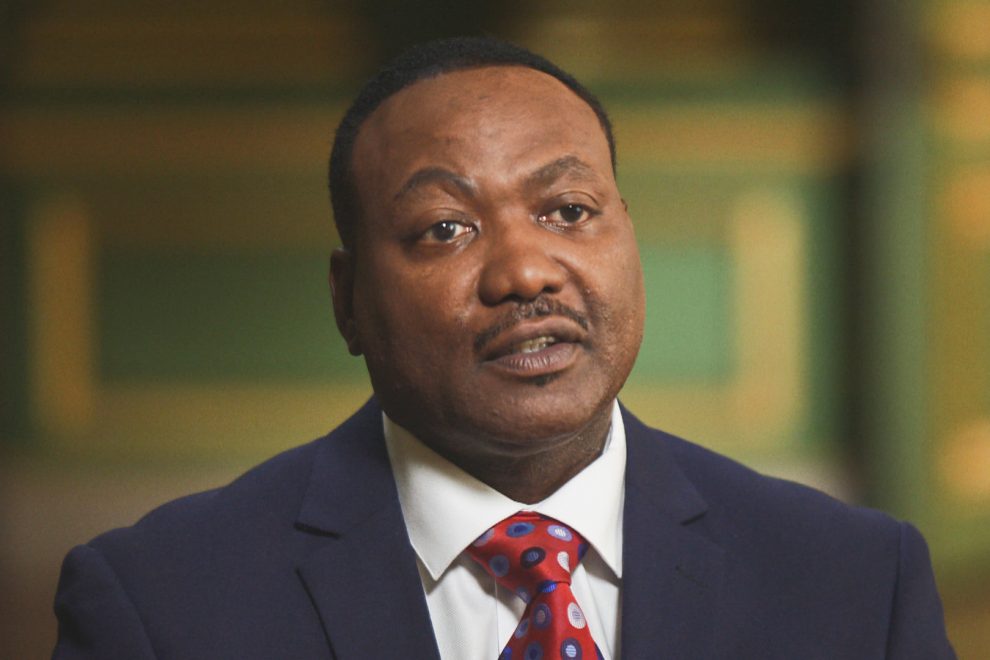In the chaotic minutes before he shot and killed Ashli Babbitt during the Capitol riot on Jan. 6, Lt. Michael Byrd focused his attention on the glass doors leading into the lobby of the House of Representatives chamber.
About 60 to 80 House members and staffers were holed up inside, and it was Byrd’s job to protect them.
As rioters rampaged through the Capitol, Byrd and a few other officers of the U.S. Capitol Police set up a wall of furniture outside the doors.
“Once we barricaded the doors, we were essentially trapped where we were,” Byrd said in an exclusive interview with NBC News’ Lester Holt, speaking publicly for the first time since the riot. “There was no way to retreat. No other way to get out.
“If they get through that door, they’re into the House chamber and upon the members of Congress,” added Byrd, who gave NBC News permission to use his name after authorities had declined to release it.
Byrd’s connection to what was going on outside and inside the building was his police radio. For several minutes, it crackled with a cascade of alarming messages.
There were shouts of officers down. Screams from his colleagues under attack by rioters with chemical agents. A report that an officer’s fingertips were blown off.
“It was literally broadcast over the air,” Byrd said. “I said, ‘OK, this is getting serious.’”
Soon a horde of demonstrators arrived. Byrd, a 28-year veteran of the Capitol Police, took a defensive posture with his gun drawn as rioters smashed the glass doors.
He said he yelled repeatedly for them to get back. But the mob kept pressing forward, and then a lone rioter tried to climb through one of the doors.
What happened next was captured on video: Byrd fired one shot, striking Babbitt in the shoulder.
Babbitt, 35, an Air Force veteran and ardent supporter of former President Donald Trump, fell to the ground; she died from her injuries later.
Her death became a rallying cry for the far right, which described Babbitt as a martyr. Trump himself declared that she had been murdered and suggested, falsely, that the officer who shot her worked for a high-ranking Democrat.
For Byrd, who is Black, the incident turned his life upside down. He has been in hiding for months after he received a flood of death threats and racist attacks that started when his name leaked onto right-wing websites.
But in his interview with Holt, Byrd said he has no doubt that he made the right decision in light of the circumstances.
“I know that day I saved countless lives,” Byrd said. “I know members of Congress, as well as my fellow officers and staff, were in jeopardy and in serious danger. And that’s my job.”
Byrd said he had no idea whether the person he shot was carrying a weapon. It was only later that night that he found out that the rioter was a woman who was unarmed.
Asked why he pulled the trigger, Byrd said it was a “last resort.”
“I tried to wait as long as I could,” he told Holt. “I hoped and prayed no one tried to enter through those doors. But their failure to comply required me to take the appropriate action to save the lives of members of Congress and myself and my fellow officers.”
Byrd has been cleared of wrongdoing by the Justice Department and the Capitol Police. In announcing its decision not to charge him, the Justice Department said in April that investigators had examined video, physical evidence from the scene, autopsy results and statements from the officer involved, as well as other officers and witnesses.
“The investigation revealed no evidence to establish that, at the time the officer fired a single shot at Ms. Babbitt, the officer did not reasonably believe that it was necessary to do so in self-defense or in defense of the Members of Congress and others evacuating the House Chamber,” federal prosecutors said in a statement.
‘The chants got louder’
The days before Jan. 6 were business as usual for Byrd, a Washington native. He and other Capitol Police officials met to review the security plan for the certification of Joe Biden’s victory in the presidential election.
“We did not get specific intel that would require us to change or adjust our posture,” he said. “At that point, it felt like a routine event that I’ve done over the last 28 years of my career.”
Byrd said there was one complicating factor: Fewer officers were under his command, in large part because of Covid-19-related absences.
When hundreds of Trump supporters upset over the results of the election moved on the Capitol, the images of violent clashes were broadcast live on television. But Byrd, stationed outside the House chamber, wasn’t able to watch. He was dependent on his police radio.
When Byrd started hearing reports of officers down, he didn’t know the extent of their injuries. At one point, Byrd said, an even more alarming message came over the radio: a report of shots fired, which he learned much later was false.
Byrd said that after he heard the radio chatter warning that rioters had breached the building, he rushed inside the chamber and instructed the House members to hide under their chairs and to stay away from doors and windows.
He said he told them that pipe bombs had been found in the vicinity of the building and that rioters were using weapons against officers. You need to gather your gas masks, Byrd said he told them.
And he gave one more crucial instruction: He told the House members to take measures to disguise who they were in case they came face to face with the rioters.
“One of the things that was imperative was to inform the members to remove their pins to allow them to blend in,” Byrd said. “To remove their jackets, to look like staff as much as possible.”
As Byrd rushed out of the chamber, he saw the House chaplain take the position he had left on the podium. The chaplain began to recite a prayer with the members of Congress.
“I believe it was at that point in time” that “the members, as well, started to believe serious harm or injury could come to them,” Byrd said.
Byrd said he and the other officers quickly erected the makeshift barricade using every piece of furniture they could find.
“At that point is when I realized they’re here,” Byrd said, referring to the rioters. “The chants got louder. I couldn’t make out what they were saying, but it sounded like hundreds of people outside of that door.”
Video shot by a person in the crowd showed two officers posted in front of the door. Heavily outnumbered, they eventually stepped aside.
Byrd said he had no knowledge that any officers were there. Because of the furniture stacked on his side of the door, he also couldn’t make out how many people were on the other side or whether they were carrying weapons.
“It was impossible for me to see what was on the other side,” he said.
But he did see the person now known to be Babbitt start coming through the broken glass.
“I could not fully see her hands or what was in the backpack or what the intentions are,” Byrd said. “But they had shown violence leading up to that point.”
It was the first time Byrd had ever shot his weapon in his 28 years on the force. Over the next few minutes, he helped the House members evacuate the building. He said it wasn’t until later that night, when he got the chance to watch TV coverage, that he understood the full scope of the Capitol riot.
The Babbitt family’s attorney has described the incident as an “ambush,” alleging that the officer gave no warning before he pulled the trigger. Babbitt’s family has signaled its intention to file a civil lawsuit against the Capitol Police; it had previously filed court papers seeking the name of the officer who shot her.
The attorney, Terry Roberts, didn’t respond to a request for comment.
Byrd said he felt pain in his throat for days afterward from yelling at the protesters to stop and step back as they pounded on the glass doors.
Byrd also scoffed at the allegations by some that he had a political agenda.
“I do my job for Republican, for Democrat, for white, for Black, red, blue, green,” he said. “I don’t care about your affiliation.”
He noted that when Trump was president, he escorted him through the Capitol on numerous occasions. “If he was in the Capitol and I was responsible for him, I’d do the same thing for him and his family,” Byrd said.
In the days after Jan. 6, Byrd’s name leaked out in right-wing media and online forums. Then came the threats.
“They talked about killing me, cutting off my head,” Byrd said, adding that there were also racist attacks.
“It’s all disheartening, because I know I was doing my job.”
The hardest part, he said, has been the effect on his family. A tear slid out of Byrd’s eye and trickled down his right cheek as he lamented how the life he built has been upended.
“Sometimes, you can’t do anything but cry,” Byrd said, his voice growing heavy. “You felt like you did your job. You helped protect our legislative leaders of this country and you fought for democracy and keeping them established.”
An incident in Byrd’s past has also gained renewed attention online: In 2019, he left his service weapon in a bathroom, where another officer eventually discovered it.
In the NBC News interview, Byrd described the incident as a “terrible mistake.”
“I owned up to it. I was penalized for it. I moved on,” he said.
After having remained silent for seven months as the investigations dragged on, Byrd said he wanted to speak out to counter the misrepresentations of his actions that day, even if doing so exposes him to more threats and vitriol.
“It’s something that is frightening,” Byrd said. “Again, I believe I showed the utmost courage on January 6, and it’s time for me to do that now.”
He said that he knows there are people who disagree with his actions that day and that they may always.
“I hope they understand I did my job,” Byrd said. “There was imminent threat and danger to the members of Congress. I just want the truth to be told.”
Story cited here.
























